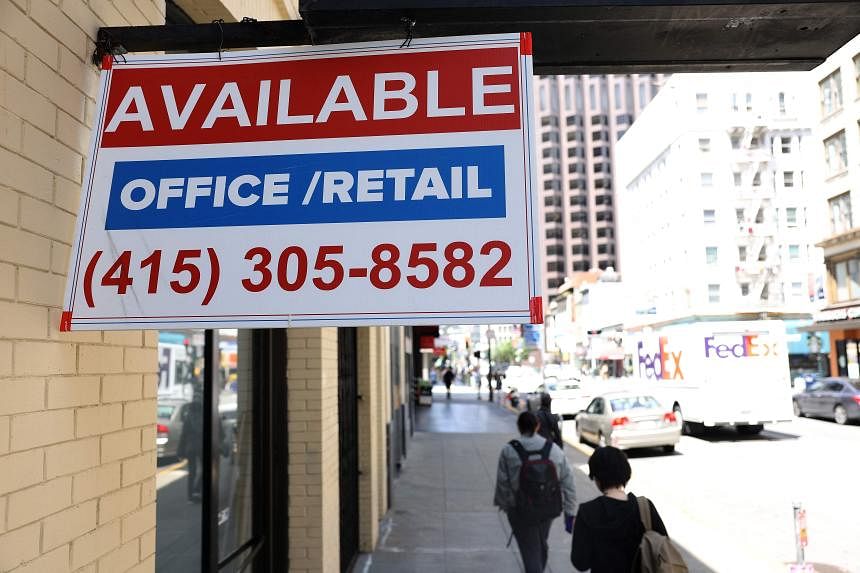SINGAPORE – Local banks’ exposure to United States property, including its ailing commercial real estate sector, is small as a share of the banking sector’s total loan portfolio, and does not present systemic concerns, market observers said.
The Monetary Authority of Singapore (MAS) monitors the country’s banking system exposure for financial stability purposes, they said, adding that the regulator’s mission will see it continuing to monitor developments in the US for potential contagion effects on Singapore.
The US commercial real estate sector has been under pressure as interest rates have risen over the past two years.
As a result, many property developers are struggling to refinance their debts, forcing some banks to boost their reserves for loan losses.
About 14 per cent of all commercial real estate loans and 44 per cent of loans on office buildings appear to be in a negative equity position, meaning the debt is greater than the property value, according to the US National Bureau of Economic Research. This increases the risk that borrowers will not repay and will default on their loans.
As a result, commercial property values have fallen by 22 per cent since the first quarter of 2022, when the US Federal Reserve began raising interest rates, while office prices have tumbled 35 per cent as demand for office space weakened following the adoption of remote work, according to analytics firm Green Street.
In 2023, MAS said an industry-wide stress test affirmed that banks in Singapore have adequate capital and liquidity buffers to weather potential downside risks arising from severe macro-financial stresses.
The adverse-stress scenarios include a severe downturn in the US economy and strains in the banking system triggered by the commercial real estate crisis, among other factors.
During the recent earnings reporting season in February, local banks said their exposure to US commercial real estate is less than 1 per cent of their respective loan books, which is considered non-significant.
DBS group chief executive officer Piyush Gupta said the bank’s exposure to commercial real estate “is about $90 billion”, of which most are mixed projects comprising retail, residential and office spaces.
Singapore accounts for around $55 billion or 60 per cent of DBS’ total commercial real estate exposure, and the local market is quite robust.
Hong Kong accounts for $18 billion or 20 per cent, down from $19 billion in the third quarter. About $13 billion is in mixed-use projects, and the remaining $5 billion is split equally between retail and office, Mr Gupta said.
The US accounts for $1 billion of the total commercial real estate exposure, while another $6 billion to $7 billion is in Britain and Europe, mostly in Singapore-led projects.
OCBC Bank, in its recent 2023 results, said loans to the US commercial real estate office space accounted for 0.7 per cent of the group’s loan book.
According to some estimates, the local asset management industry’s exposure to US real estate is also small. This includes exposure to US real estate investment trusts (Reits).
The most obvious distress stems from Singapore-listed Reits with exposure to US commercial real estate, such as Manulife US Reit, whose portfolio was hit by low occupancy and sliding asset valuations. It recently announced the resignation of its senior management, effective on June 30, even as it completed its recapitalisation plan.
There is also Keppel Pacific Oak US Reit, which is facing a double whammy of lower portfolio valuations and higher interest costs. The Singapore-listed Reit said in February that it is suspending distributions to shareholders for two years as it works on a recapitalisation plan.
Before the Covid-19 pandemic, Singapore investors were reportedly the biggest overseas commercial real estate investors in Asia, deploying billions into the United States.
According to CBRE, a total of US$32 billion (S$43 billion) in 2021 was poured by investors in Singapore into US real estate, marking a 164 per cent rebound from 2020, and higher than the pre-pandemic peaks.
But what was deemed a safe-haven investment before the pandemic has now soured as companies transitioned to hybrid working arrangements, resulting in a sharp decline in the need for large office spaces and a fall in demand for commercial real estate in the US.
To make matters worse, property owners faced high borrowing costs as the US Fed kept interest rates high.
By the end of 2023, the pool of distressed US commercial properties, led by offices and retail units, grew to US$85.8 billion, according to MSCI. Potential distress, which may precede full-blown financial trouble, totalled US$234.6 billion.
Consulting firm Klaros Group estimated that more than 280 US banks with nearly US$900 billion in total assets are at risk of needing capital because of high levels of commercial real estate and losses tied to interest rates.
S&P Global Ratings said property, including China’s distressed market, is likely the biggest risk to most financial institution ratings across the Asia-Pacific in 2024.
The credit rating agency expects that the strains on office-focused Reits and landlords in the Asia-Pacific will intensify over the next few years.
This will weaken cash flow and asset valuations for rated companies in the sector. However, the region’s office markets will likely not be hit as hard as in other regions.
“Office Reits and landlords in Asia-Pacific face dilemmas similar to peers elsewhere in the world. Tenants are downsizing as hybrid working takes root. Vacancy rates are elevated, and higher interest rates are pressuring their funding costs as well as asset values,” said S&P Global Ratings credit analyst Simon Wong.
However, he believes that the region’s office-focused Reits are in better shape than their global peers, with most having some financial buffer against scenarios of sharper declines in rents and asset value.


